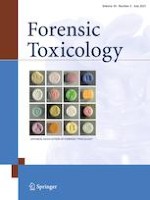Erschienen in:

22.04.2021 | Original Article
Meconium and maternal hair analysis vs. medical records to monitor antidepressants and benzodiazepines exposure during pregnancy
verfasst von:
Ángela López-Rabuñal, Elena Lendoiro, Marta Concheiro-Guisán, Eva González-Colmenero, Patricia Peñas-Silva, Ana Concheiro-Guisán, Manuel Macía-Cortiñas, Manuel López-Rivadulla, Ana de-Castro-Ríos, Angelines Cruz
Erschienen in:
Forensic Toxicology
|
Ausgabe 2/2021
Einloggen, um Zugang zu erhalten
Abstract
Purpose
Psychiatric disorders and drugs used for their treatment, can have negative consequences for the pregnancy and the development of the newborn. Therefore, meconium, maternal hair and maternal medical records were compared for the detection of antidepressants and benzodiazepines exposure during pregnancy. Moreover, correlations between neonatal outcomes and meconium or maternal hair results were evaluated.
Methods
Two liquid chromatography-tandem mass spectrometric methods for the determination of the most common benzodiazepines and antidepressants in meconium and maternal hair were applied to the analysis of 145 matched samples. Statistical analyses were performed with IBM SPSS Statistics software.
Results
According to the medical records, 5.5% of the mothers used prescribed antidepressants during pregnancy and 23.1% benzodiazepines (10.5% at the time of delivery). For antidepressants, 5.5% of meconium and 24.8% of maternal hair specimens were positive; for benzodiazepines, 16.6 and 15.9% of meconium and hair specimens, respectively, were positive. Overall agreement meconium/hair, and medical records/hair, for positive cases, was very poor (28.1 and 18.9%, respectively), while improved between medical records/meconium (60%). Regarding the evaluated neonatal parameters, we only found a significant negative correlation between male weight and meconium-positive results for benzodiazepines.
Conclusion
Maternal hair was more sensitive to detect antidepressants use, while meconium analysis can provide detection of neonatal benzodiazepines exposure at the time of delivery. Therefore, combination of both matrices is recommended, since it shows a more complete picture of prenatal exposure to these drugs. No clear influence of prenatal exposure to antidepressants or benzodiazepines on neonatal outcomes was noticed.